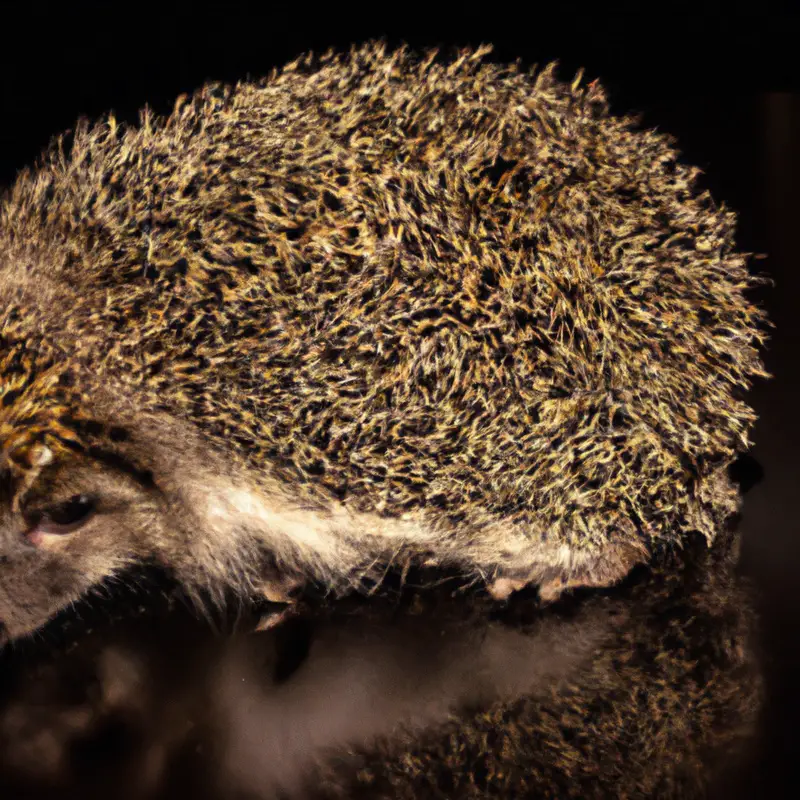How Do Hedgehogs Adapt To Different Weather Conditions?
Key Takeaways:
- Hedgehogs have a remarkable ability to adjust their behavior and hibernation patterns based on the climate and temperature of their environment.
- They use a combination of insulation from their spines and the creation of nests to protect themselves from extreme weather conditions.
- Hedgehogs’ diet changes according to the availability of food during different weather conditions.
- Their ability to respond and adapt to changing weather patterns is vital for their survival in various habitats.
Imagine walking through a picturesque forest on a crisp autumn day, when suddenly, you spot a small creature scurrying among the fallen leaves.
It’s a hedgehog, perfectly at home in its natural habitat.
But have you ever wondered how these adorable spiky creatures adapt to different weather conditions?
From cold winters to scorching summers and everything in between, hedgehogs have their own unique strategies for survival.
In this article, we’ll delve into the fascinating world of hedgehog adaptations, exploring how they brave the elements and thrive in diverse climates.
Get ready to uncover the secrets behind their resilience and discover how hedgehogs are true weather warriors.
| Weather Condition | Adaptations |
|---|---|
| Snowy and Cold |
|
| Rainy and Wet |
|
| Hot and Dry |
|
Hedgehogs and their natural habitat
Hedgehogs are found in a variety of natural habitats, including woodlands, meadows, and gardens.
The natural habitat of hedgehogs
Hedgehogs are found in a variety of habitats, but they primarily prefer areas with dense vegetation such as woodlands, hedgerows, and gardens. These habitats provide the hedgehogs with ample cover and protection from predators.
Hedgehogs also require access to water sources, such as ponds or streams, for drinking and bathing.
They are adaptable creatures and can live in rural, suburban, or urban environments. It’s important to create a hedgehog-friendly habitat by providing shelter, food, and access to water in your own garden if you want to attract hedgehogs to your area.

Hedgehog diet and lifestyle
Hedgehogs have a simple yet varied diet, consisting mainly of insects, worms, and other small invertebrates. They are also known to eat fruits, vegetables, and even small animals on occasion.
As nocturnal creatures, hedgehogs spend their nights foraging for food and rest during the day in nests or burrows.
They are solitary animals and prefer to have their own personal space. Hedgehogs are adaptable and can live in a variety of habitats, from woodlands to gardens, as long as they have access to food and shelter.
Adaptations of hedgehogs to different weather conditions
Hedgehogs have specific adaptations that help them survive in different weather conditions.
Hedgehogs and cold weather
Hedgehogs have some interesting adaptations to help them survive in cold weather.
Firstly, they have a layer of thick, insulating fur that keeps them warm.
This fur protects them from the cold temperatures and helps to retain their body heat.
Secondly, hedgehogs are able to go into a state of hibernation during the winter months.
During this time, their body temperature drops and their metabolic rate decreases significantly, allowing them to conserve energy and survive without needing to find food.
Lastly, hedgehogs build nests made out of leaves and other materials to provide further insulation and protection from the cold.
These nests are cozy shelters where they can hunker down during cold spells.
Overall, hedgehogs are well-adapted to cope with cold weather conditions.
Hedgehogs and hot weather
Hedgehogs are well-adapted to handle hot weather.
They have the ability to regulate their body temperature and can go into a state of aestivation, similar to hibernation, during extreme heat.
Hedgehogs also dig burrows to find cooler areas underground.
They reduce their activity during the day and are more active at night to avoid the hottest temperatures.
They also seek out shaded areas or vegetation to hide in during the day.

Hedgehogs and rainy weather
Hedgehogs are well adapted to rainy weather. They have a thick coat of spines which helps to protect them from getting wet.
Their spines work as a waterproof barrier, preventing rain from reaching their skin.
Additionally, hedgehogs have the ability to roll into a tight ball, covering their head and body. This behavior helps them to stay dry and avoid getting waterlogged during rainy periods.
Hedgehogs also have a natural instinct to seek shelter, such as finding a cozy spot under bushes or in piles of leaves, when it is raining.
These adaptations allow hedgehogs to effectively navigate and survive in rainy weather conditions.
Hedgehogs and hibernation
Hedgehogs undergo a process of hibernation to survive extreme weather conditions.
They prepare for hibernation in order to conserve energy during the colder months.
Hedgehog hibernation process
During hibernation, hedgehogs enter a state of deep sleep to conserve energy.
They lower their body temperature and heart rate, and their breathing becomes slow and shallow.
Hedgehogs find a sheltered spot, such as under leaves or in a nest, to hibernate.
This process helps them to survive harsh winter conditions when food is scarce.
They rely on their fat reserves and can hibernate for several months without food or water.
When the weather becomes warmer, hedgehogs gradually wake up and resume their normal activities.
How hedgehogs prepare for hibernation
Hedgehogs prepare for hibernation by doing several things.
Firstly, they start eating more to build up fat reserves, which they will live off during hibernation.
Secondly, they find a cozy spot, such as a nest or a pile of leaves, to hibernate in.
Thirdly, they lower their body temperature and slow down their metabolism to conserve energy.
Lastly, they create a protective layer of spines to keep them safe while they sleep through the winter.
Overall, hedgehogs have a remarkable ability to adapt to different weather conditions by preparing themselves for hibernation.
Hedgehogs and seasonal changes
Hedgehogs adapt their behavior to different seasons to survive changing weather conditions.
Hedgehog behavior during spring
During spring, hedgehogs become more active and start seeking mates.
They may engage in courtship displays, such as chasing and sniffing each other.
Hedgehogs also start building nests for their young using leaves and grass.
They venture out in search of food, feasting on insects, worms, and other small invertebrates that become more abundant during this season.
Hedgehogs may also experience a change in their sleep patterns, becoming more diurnal as the days get longer.
Hedgehog behavior during summer
During the summer, hedgehogs adapt their behavior to the warmer weather. They often spend more time foraging for food at night to avoid the heat of the day.
Hedgehogs may find shady spots to rest during the hottest parts of the day and come out again in the evening.
They also take advantage of the abundance of insects during this season. Additionally, hedgehogs will continue to groom themselves regularly to keep cool and prevent parasites.
Hedgehog behavior during autumn
During autumn, hedgehogs go through a series of behavioral changes.
They start to prepare for hibernation by building nests using leaves and other materials.
They become more active at night, as they search for food to bulk up and store fat reserves for the winter.
Hedgehogs also start to explore larger territories during this time, as they try to find suitable hibernation spots.
Additionally, they may engage in mating behaviors before hibernation begins.
It’s important to provide hedgehogs with safe spaces and food sources during this season to support their hibernation and overall survival.
Hedgehog behavior during winter
During winter, hedgehogs exhibit certain behaviors to adapt to the cold temperatures.
They go into a state of hibernation, finding a safe and sheltered spot to curl up in and conserve energy.
Their body temperature drops, and their heartbeat and breathing slow down significantly.
This helps them conserve energy and survive the winter months when food is scarce.
Hedgehogs also build nests using leaves, grass, and other materials to provide insulation and protection from the elements.
Frequently Asked Questions about hedgehogs and weather adaptations
Do hedgehogs hibernate in warmer climates?
Hedgehogs do not hibernate in warmer climates. Unlike their counterparts in colder regions, hedgehogs in warmer climates do not need to go into hibernation to survive.
They are able to find enough food and maintain a comfortable body temperature throughout the year.
Instead of hibernating, hedgehogs in warmer climates may go into a period of torpor, which is a short-term state of reduced activity and metabolic rate. This helps them conserve energy during periods of extreme heat or drought.
How do hedgehogs find food during cold winters?
Hedgehogs find food during cold winters by adapting their behavior. They are opportunistic feeders and will eat a wide variety of foods.
Some hedgehogs will go into a state of torpor, where their metabolic rate slows down, allowing them to conserve energy.
They may also build up fat reserves before winter to sustain them during periods when food is scarce. Hedgehogs will forage at night, using their keen sense of smell to locate hibernating insects or any other available food sources.
This adaptive behavior helps them survive through the winter months when food is scarce.
Can hedgehogs survive in extremely hot weather?
Hedgehogs have certain adaptations that allow them to survive in hot weather.
They are able to regulate their body temperature by seeking shade during the hottest parts of the day.
They may also dig burrows or find other cool areas to escape the heat.
It’s important to provide them with access to fresh water and ensure they have a cool and shaded space to retreat to in extremely hot weather.
Final Verdict
Hedgehogs have an incredible ability to adapt to different weather conditions in order to survive.
Their natural habitat, diet, lifestyle, and behaviors all play a role in their ability to withstand extreme temperatures and climates.
Hedgehogs have various adaptations that help them cope with cold, hot, and rainy weather, including changes in metabolism, insulation, and activity levels.
Additionally, their ability to hibernate during winter and adjust their behavior during different seasons further enhances their chances of survival.
Despite some challenges, hedgehogs have proven their resilience and adaptability, making them fascinating creatures to study and appreciate.







